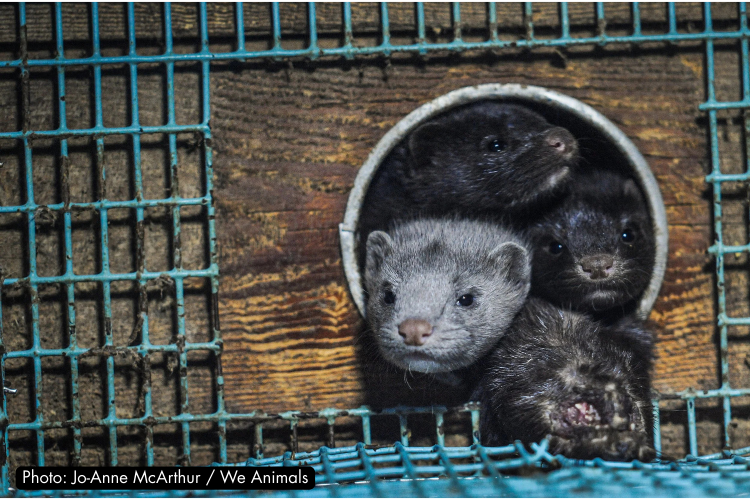Saved: foxes, raccoons and wolf-dogs among the hundreds of animals rescued from Ohio fur farm
The animals were kept in “filthy” wire cages with little-to-no protection from the cold weather, and many were emaciated and severely dehydrated.
A fox being kept captive on the fur farm in Ohio. Credit: HSUS
Hundreds of animals have been rescued from a fur and urine farm in the US, in a case which rescuers described as “one of the most horrific situations” they’d ever seen.
Foxes, raccoons, wolf-dog hybrids, skunks, opossums and coyotes were among those saved from the farm based near Cleveland, Ohio.
Known as the Grand River Fur Exchange, the farm had reportedly been keeping animals in dire conditions.
But after the owner passed away in December last year, the animal welfare crisis at the facility went from bad-to-worse and Ohio authorities had to step in and request the assistance of the Humane Society of the United States (HSUS) to help mount a rescue operation.
When rescuers first arrived on the scene, they discovered animals living in “filthy” wire-bottom cages with little-to-no protection from the frigid conditions. Many of the animals were found to be emaciated and severely dehydrated.
A wolf-dog hybrid at the fur farm in Ohio. Credit: HSUS
Some of the animals had missing toes, ears, tails and limbs. Veterinarians concluded that animals likely lost toes due to the cages’ painful wire flooring. Other animals who were missing limbs and paws had likely been caught in steel-jaw leghold traps that were found around the property.
Several animals were declared dead at the scene, including some found covered in snow, while one coyote was found dying slowly while captured in a leghold trap.
Responders from HSUS initially had to provide daily care to the animals on the property for several weeks while working with Ohio authorities to arrange suitable new homes for the animals at licensed wildlife rehabilitators and accredited sanctuaries around the US.
The rescue operation concluded on January 25, after the last groups of animals were safely removed from the property. In total, more than 330 animals were rescued from the farm and were successfully moved to safe locations.
A rescuer cradles an animal at the Ohio fur farm. Credit: HSUS
The animals being bred on the farm were destined to be slaughtered for their fur, with documents found on site indicating the owner had sold pelts to Fur Harvesters Auction, the last remaining fur auction house in North America.
Some of the captive animals were also being bred to be sold as exotic pets, while others were being held for urine farming.
Predator urine is typically used in hunting and trapping, but can also be sold as a wild animal deterrent for gardeners.
Rescuers also discovered that while some of the animals on the farm had been bred in captivity, others had been taken from the wild after being trapped in painful leghold traps.
“This is one of the most horrific situations I have ever seen—the terror and pain was palpable,” said Adam Parascandola, president of the HSUS’ Animal Rescue Team. “Our team is exposed to immense cruelty in the criminal cases we regularly respond to like dogfighting and severe neglect, yet this stands out both in terms of suffering and because of these fur farming practices. It’s haunting.”
“Horrific” fur farming in the US
The shocking cruelty involved in the case has highlighted how fur farming in the US is often overlooked, with the average American likely unaware that the controversial practice still continues in the country.
According to HSUS, the US fur trade “has long operated in the shadows with zero oversight”. The Grand River Fur Exchange had already previously been fined back in 2011 by USDA which prohibited the operator from engaging in the breeding and sale of wild animals, yet it appears that the fur farm was able to continue to engage in those practices without further enforcement.
A row of cages at the Ohio fur farm. Credit: HSUS
This lack of oversight reflects a lack of welfare regulations surrounding the fur trade in the US. Currently, there are no federal regulations related to the welfare, care or slaughter of animals farmed for their fur.
In Ohio, where the Grand River Fur Exchange was licensed by the Ohio Department of Natural Resources, the state does not have laws or standards of care for fur farms or slaughter.
The only state-level law that exists in the US is New York’s ban on anal and genital electrocution of foxes.
Despite the lack of regulation, the declining consumer demand for animal fur products is resulting in a decline in fur farms in the US.
Recent census data shows that the number of mink fur farms in the country fell by more than half in five years with 236 mink fur farms in 2017 falling to just 110 remaining in 2022. This decline resulted in the number of mink being filled for their fur falling from 3.3 million mink to 1.3 million over the same time period.
But in a reflection of the lack of transparency in the industry, other species including fox fur farms are not tracked by the USDA, so it is not known how many there are in the country.
We Have A Favor To Ask…
Species Unite amplifies well-researched solutions to some of the most abusive animal industries operating today.
At this crucial moment, with worldwide momentum for change building, it’s vital we share these animal-free solutions with the world - and we need your help.
We’re a nonprofit, and so to keep sharing these solutions, we’re relying on you - with your support, we can continue our essential work in growing a powerful community of animal advocates this year.







